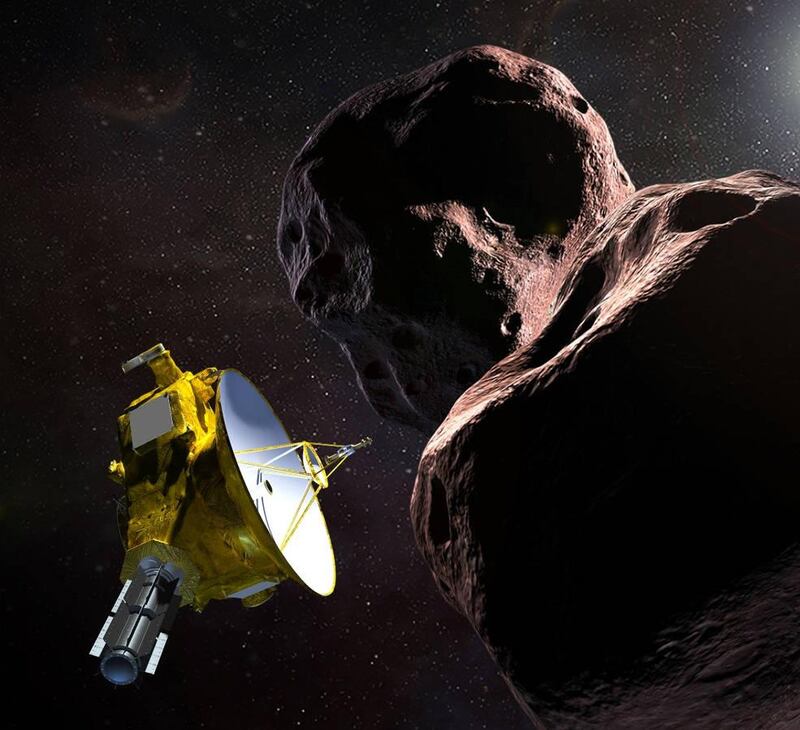Nasa scientists are expected to make history today when they attempt the most distant fly-by of a celestial body yet.
Shortly after 9.30am UAE time, the New Horizons probe will zip past a mysterious 30 kilometre-wide object nicknamed Ultima Thule, which lies about 6.5 billion kilometres from Earth. That’s more than 2 billion kilometres beyond the outermost planet, Neptune.
To put the encounter into perspective, if our planet were shrunk to the size of an orange, the fly-by would be happening more than 50km away.
Yet such is the skill of its controllers, the probe is expected to zoom safely by the object at about 50,000kph, take crystal-clear pictures and then beam them back to Earth.
Even travelling at the speed of light, it will take six hours for the images to cross the void between the probe and its home planet.
This is no mere New Year Day’s stunt, however. Those images will be pored over by astronomers trying to solve one of the greatest mysteries in science: how our solar system was formed.
Ultima Thule – Latin for a place beyond the known world – is a Kuiper Belt object, belonging to a vast band of primordial debris that has been silently orbiting the Sun for billions of years far beyond the known planets. Despite being under the influence of the Sun’s gravitational field, the object is expected to have remained unsullied by the events that took place about 4.6 billion years ago, when the major planets began to take shape.
As such, Ultima Thule is probably the most pristine relic of whatever existed before the creation of the solar system.
Until now, it remained simply a blurry dot even in images taken by the world’s largest telescopes since its discovery in 2014.
If all goes to plan, that will change later today when the first close-up reaches mission control at Johns Hopkins University, Maryland.
That may resolve the first question surrounding Ultima Thule: its shape.
Despite the colossal distance, Earth-bound telescopes have been able to glean insights from the incredibly feeble sunlight reflected from its surface.
This has revealed that the object is reddish in colour – probably the result of its surface being blasted by space radiation for billions of years.
________________
Read more from Science:
Scientists aim to dim the sun to tackle climate change
Crowded carpooling stresses out camels, study shows
Sugar-packed drinks turning adolescents into addicts
________________
In 2017, the object passed in front of a distant star and the effect on the starlight suggested Ultima Thule has an elongated, peanut-like shape, or might even be two objects orbiting each other.
That was what astronomers were expecting from so small an object, its gravity being too weak to mould it into a ball-like body like a planet.
But as the New Horizons probe closed in on its target, its controllers noticed something odd. The amount of sunlight reflected from Ultima Thule should have been changing over hours and days as it tumbles through space. Instead, its so-called “light curve” shows no variation at all.
Quite why is a mystery. One possibility is that the object is spinning, but the axis of spin is pointed straight at the spacecraft, thus making its motion invisible. Another idea is that the object is surrounded by a dust cloud that mops up the light – although the origin of the dust is a mystery. Or perhaps the object is surrounded by a swarm of boulders that blocks the reflected light.
Whatever the cause, it is unlikely to stay a mystery for much longer.
But the most important data sent back by New Horizons will be the measurements giving insight into what Ultima Thule is made of.
As its feeble gravity tugs at the probe, the resulting swerve in trajectory will be used by mission controllers to measure the object’s mass. Estimates of the object’s volume will then be extracted from the imaging cameras. A simple calculation then reveals an estimate of the object’s density – and thus its composition.
If the density comes out below that of water, it suggests Ultima Thule is porous and icy.
That hints at a link with comets, the “dirty snowballs” that periodically dive deep into the solar system.
If its density proves to be higher, the object is likely to be more rocky. That would point to an origin closer to the Sun.
Either way, astronomers will get vital clues to how Ultima Thule – and Kuiper Belt objects in general – fit into the Sun’s family of objects.
That, in turn, will feed into theories of how the planets formed. For the truth is that, even almost exactly 50 years since Nasa first sent astronauts around the Moon in Apollo 8, mystery still surrounds the origin of our solar system. It is a mystery that has deepened with the discovery of thousands of planets around other stars.
Today’s fly-by promises to give the first glimpse of one of the strangest pieces in that cosmic jigsaw-puzzle.
Robert Matthews is Visiting Professor of Science at Aston University, Birmingham.






